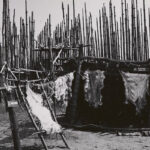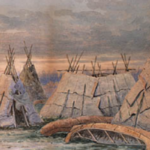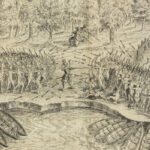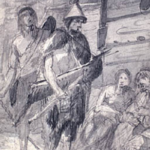The Champagne and Aishihik First Nations (CAFN), deeply rooted in the southwestern Yukon, offer a narrative that spans millennia of resilience, adaptation, and innovation. This essay delves into their prehistory, the arrival of European explorers, the relationships formed during contact, and their evolution into a self-governing First Nation in the modern era. Drawing on detailed historical evidence, the narrative explores the unique aspects of the CAFN’s journey.
Prehistory and Arrival in the Yukon
The Champagne and Aishihik peoples belong to the Southern Tutchone linguistic group, a branch of the Athabaskan language family. Archaeological evidence reveals that their ancestors have inhabited the region for over 8,000 years, adapting to the challenging subarctic climate. Seasonal mobility defined their existence, as they moved between summer salmon-fishing sites and winter hunting grounds. Tools and artifacts, such as copper blades and birchbark containers, illustrate their ingenuity and connection to the land (Greer, 1997).
A defining aspect of CAFN prehistory is the discovery of Kwaday Dän Ts’ìnchi (“Long Ago Person Found”), a preserved individual found in the Tatshenshini-Alsek region in 1999. The remains, dated to over 300 years ago, provided unprecedented insight into their ancestors’ diets, trade networks, and use of alpine areas for resource gathering (Richards et al., 2007). DNA analysis revealed direct connections to modern CAFN members, underscoring their deep historical roots in the region.
First Contact with Europeans
The Champagne and Aishihik First Nations experienced indirect European influence through trade networks long before direct contact. Coastal Tlingit traders acted as intermediaries, introducing European goods like iron tools and textiles to the interior. This exchange reshaped traditional economies, as Indigenous groups adapted new materials into their practices (Muckle, 2011).
Direct contact began in the 19th century with the arrival of fur traders from the Hudson’s Bay Company. Trading posts established in the region facilitated the exchange of furs for goods but also introduced diseases such as smallpox, which decimated Indigenous populations. Despite these challenges, the CAFN maintained their traditional way of life, blending new technologies with established practices.
Relationships with Settlers and Missionaries
The late 19th century brought the Klondike Gold Rush, a pivotal moment in the history of the Yukon. Thousands of prospectors passed through CAFN territory, bringing profound social and environmental changes. The CAFN played an active role during this period, offering guiding services, food, and logistical support to miners. However, the influx of settlers also resulted in land displacement and competition for resources, disrupting their seasonal subsistence patterns (Coates, 1985).
Missionaries sought to convert the CAFN to Christianity, often clashing with traditional spiritual beliefs. Anglican and Roman Catholic missions established schools and churches, which became centres of cultural suppression. Despite these pressures, the CAFN found ways to preserve their heritage, blending Christian teachings with their own spiritual practices (Greer, 1997).
Transition to Modern Governance
The 20th century saw significant challenges for the CAFN. Assimilation policies, including residential schools, inflicted deep cultural and emotional wounds. Many CAFN children were forcibly removed from their families and sent to distant schools, where they faced neglect and abuse. These experiences left intergenerational scars that continue to shape their community (Sandlos & Keeling, 2021).
In the 1970s, the land claims movement provided a platform for the CAFN to assert their rights. Alongside other Yukon First Nations, they participated in negotiations that culminated in the signing of the Umbrella Final Agreement in 1993. This agreement laid the foundation for modern self-governance, granting the CAFN authority over their traditional lands and resources (Muckle, 2014).
The CAFN self-governance agreement, signed in 1995, was a historic milestone. It allowed the First Nation to establish its constitution, control its internal affairs, and implement cultural preservation programs. This autonomy marked a significant step toward reversing the legacy of colonialism and fostering community resilience.
Contemporary Champagne and Aishihik Society
Today, the Champagne and Aishihik First Nations are leaders in cultural revitalization and environmental stewardship. The preservation of the Southern Tutchone language is a central focus, with language immersion programs and cultural camps designed to reconnect younger generations with their heritage. The Dä Kų Cultural Centre serves as a hub for these initiatives, showcasing CAFN art, history, and traditions (Greer, 1997).
The CAFN have also embraced sustainable economic development. Initiatives in eco-tourism, renewable energy, and resource management align with their traditional values while providing economic opportunities. Projects like the Kluane National Park and Reserve co-management demonstrate their commitment to balancing conservation with community needs.
Environmental advocacy remains a priority, particularly in the face of climate change. The CAFN collaborate with researchers and policymakers to address challenges such as shifting wildlife patterns and changing ecosystems. Their traditional knowledge is invaluable in developing adaptive strategies that honour both cultural and ecological integrity (Richards et al., 2007).
Conclusion
The Champagne and Aishihik First Nations embody a history of resilience, adaptation, and cultural pride. From their ancient roots in the subarctic to their encounters with European traders and their emergence as a self-governing nation, their story highlights the enduring strength of Indigenous communities. Their contributions to cultural preservation and environmental stewardship underscore the importance of integrating traditional knowledge into modern governance. The CAFN’s journey serves as a powerful example of the richness and complexity of Canada’s Indigenous histories.
References
- Coates, K. S. (1985). Canada’s Colonies: A History of the Yukon and Northwest Territories. James Lorimer & Company.
- Greer, S. C. (1997). “Traditional Knowledge in Site Recognition.” At a Crossroads: Archaeology and First Peoples in Canada.
- Muckle, R. J. (2011). The First Nations of British Columbia: An Anthropological Overview. UBC Press.
- Richards, M. P., et al. (2007). “Radiocarbon Dating and Dietary Stable Isotope Analysis of Kwaday Dän Ts’ìnchi.” American Antiquity.
- Sandlos, J., & Keeling, A. (2021). Mining Country: A History of Canada’s Mines and Miners. UBC Press.



